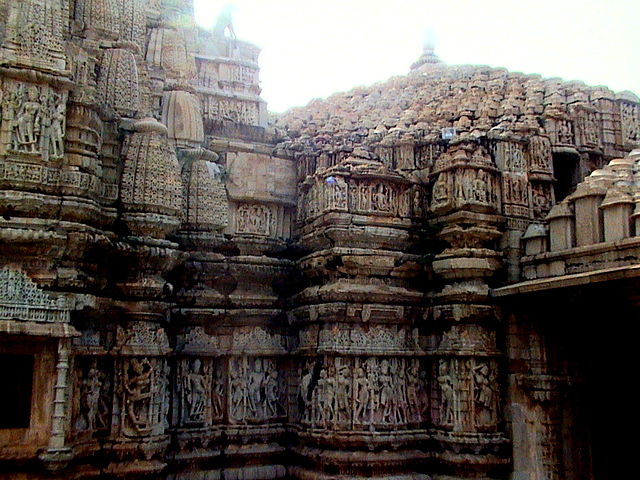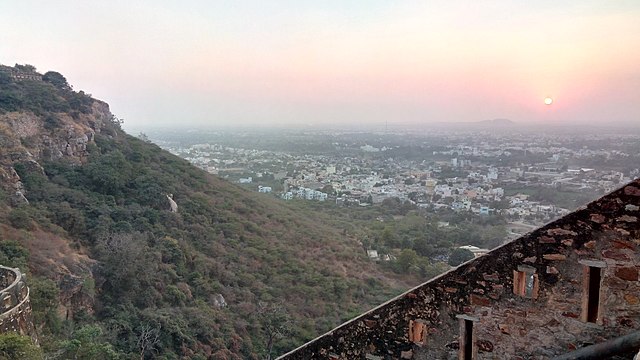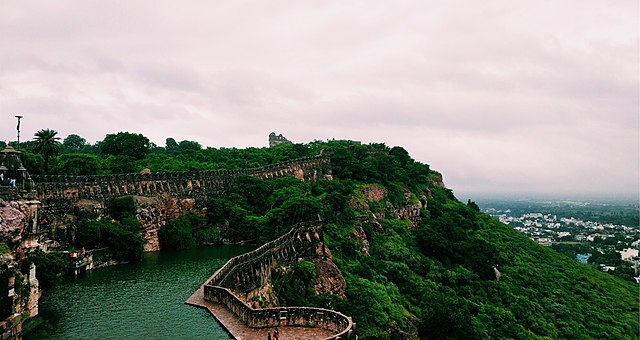Picture this: a colossal fort perched atop a hill, its walls whispering tales of bravery, sacrifice, and unyielding spirit. That’s Chittorgarh for you, a living testament to Rajasthan’s rich history and the indomitable Rajput pride. Nestled in the heart of Rajasthan, India, Chittorgarh Fort isn’t just a structure—it’s a saga carved in stone. Spanning 700 acres, it’s one of the largest forts in India, a UNESCO World Heritage Site, and a must-visit for anyone craving a deep dive into India’s past. Ready to explore this magnificent fortress with me? Let’s embark on a journey through time, where every tower, temple, and tale has something extraordinary to share.
Unveiling Chittorgarh: A Glimpse into Its Grandeur
Chittorgarh Fort, fondly called Chittor or Chittod, isn’t just a fort—it’s a symbol of Rajput valor. Built in the 7th century by the Mauryans, it served as the capital of the Mewar kingdom for centuries. Imagine a fortress so vast it feels like a city, with palaces, temples, and towers that tell stories of battles and resilience. Its strategic location on a 180-meter-high hill gave it a commanding view, making it a formidable stronghold. But what makes Chittorgarh truly special? It’s the spirit of the people who lived here, their courage immortalized in every stone.
A UNESCO World Heritage Site
In 2013, Chittorgarh Fort earned its place on the UNESCO World Heritage list, and for good reason. It’s not just about its size—though sprawling over 700 acres is no small feat. The fort is a treasure trove of history, architecture, and culture. From its intricately carved temples to its towering victory monuments, it’s a living museum that draws historians, architects, and travelers alike. Ever wondered what makes a site worthy of such global recognition? It’s the way Chittorgarh encapsulates the essence of Rajputana pride and heritage.
The Historical Tapestry of Chittorgarh

Chittorgarh’s history reads like an epic novel, filled with tales of heroism, tragedy, and defiance. The fort has witnessed three major sieges, each leaving an indelible mark on its legacy. From the heroic resistance of Rana Kumbha to the heartbreaking Jauhar ceremonies, Chittorgarh’s past is a rollercoaster of emotions. Let’s unravel some of these pivotal moments that shaped its story.
The First Siege: Alauddin Khilji’s Obsession
In 1303, Alauddin Khilji, the Delhi Sultan, laid siege to Chittorgarh, driven by tales of Queen Padmini’s unmatched beauty. Legend has it that his obsession led to a brutal battle. The Rajputs, led by Rani Padmini and her husband Rawal Ratan Singh, fought valiantly, but the fort fell. Rather than surrender, the women performed Jauhar—a mass self-immolation to protect their honor. It’s a haunting reminder of the sacrifices made to defy tyranny. Can you imagine the courage it took to face such a fate?
The Second Siege: Bahadur Shah’s Invasion
Fast forward to 1535, and Chittorgarh faced another challenge when Bahadur Shah of Gujarat attacked. The fort, under the regency of Rani Karnavati, stood strong, but the odds were overwhelming. Once again, the women of Chittorgarh chose Jauhar over captivity. The fort’s walls, soaked in the blood of warriors and the flames of sacrifice, became a symbol of unyielding spirit. It’s a story that makes you wonder: how much can the human spirit endure?
The Third Siege: Akbar’s Conquest
In 1567, Mughal Emperor Akbar set his sights on Chittorgarh. The siege lasted months, with the Rajputs, led by Jaimal and Patta, fighting to the last breath. When defeat loomed, thousands of women performed Jauhar, and the men charged into a final battle, embracing death over dishonor. The fort fell in 1568, but its legacy of resistance lived on. These stories aren’t just history—they’re the heartbeat of Chittorgarh.
Architectural Marvels of Chittorgarh Fort
Beyond its history, Chittorgarh’s architecture is a feast for the eyes. The fort is a blend of Rajput and Jain influences, with intricate carvings, soaring towers, and sprawling palaces. It’s like walking through a gallery of medieval art, where every structure tells a story. Let’s explore some of the fort’s architectural gems.
Vijay Stambh: The Tower of Victory
Standing tall at 37.19 meters, the Vijay Stambh, or Tower of Victory, is a nine-story masterpiece built by Rana Kumbha in 1458 to commemorate his victory over Mahmud Shah. Its intricate carvings depict Hindu deities, warriors, and mythical creatures. Climbing its narrow stairs to the top is like stepping into a time machine, offering panoramic views of the fort and beyond. Ever wondered what it feels like to stand atop a monument of triumph?
Kirti Stambh: The Tower of Fame
Dedicated to the Jain tirthankara Adinath, the Kirti Stambh is a 22-meter tower adorned with Jain sculptures. Built in the 12th century, it’s a testament to the fort’s religious diversity. The delicate carvings and serene aura make it a must-visit for those seeking spiritual solace amidst the fort’s grandeur.
Rana Kumbha Palace
The Rana Kumbha Palace is where history feels alive. This sprawling complex, though partly in ruins, once housed the mighty Rana Kumbha. It’s also the site where Rani Padmini is said to have performed Jauhar. Walking through its corridors, you can almost hear the echoes of royal gatherings and tragic farewells.
Padmini Palace: A Romantic Legend
Nestled by a lotus-filled lake, the Padmini Palace is as romantic as it is tragic. Legend says Alauddin Khilji caught a glimpse of Rani Padmini’s reflection here, sparking his obsession. The palace’s serene setting belies its tumultuous history, making it a poignant stop for visitors.
Temples That Echo Spirituality
Chittorgarh isn’t just about battles and palaces—it’s a spiritual haven too. The fort houses several temples, each a masterpiece of architecture and devotion. These sacred spaces offer a glimpse into the religious fervor of the Mewar rulers.
Kumbha Shyam Temple
Dedicated to Lord Vishnu, the Kumbha Shyam Temple is a fine example of Rajput architecture. Its intricate carvings and serene ambiance make it a place of peace amidst the fort’s ruggedness. Visiting here feels like stepping into a sanctuary where time stands still.
Meera Temple: A Poetess’s Devotion
The Meera Temple, dedicated to the mystic poetess Meera Bai, is a tribute to her unwavering devotion to Lord Krishna. Built in the 16th century, its simple yet elegant design reflects Meera’s spiritual purity. If you’re a fan of poetry or spirituality, this temple will tug at your heartstrings.
Life Inside Chittorgarh Fort

Chittorgarh wasn’t just a fortress—it was a thriving city. Even today, it’s home to a small community living within its walls. Imagine living in a place where every corner holds a piece of history! The fort has seven gates, each with its own story, and water bodies like Gaumukh Reservoir that ensured self-sufficiency. It’s like a self-contained world, blending the past with the present.
The Seven Gates of Chittorgarh
The fort’s seven gates—Padan Pol, Bhairon Pol, Hanuman Pol, and others—served as layers of defense. Each gate is a reminder of the fort’s strategic brilliance. Walking through them feels like crossing thresholds of time, each one guarding secrets of the past.
Water Bodies and Reservoirs
Chittorgarh’s water management was ahead of its time. With over 80 water bodies, including the Gaumukh Reservoir, the fort was self-sufficient even during sieges. The reservoir, fed by a natural spring, is named for its cow-shaped outlet. Isn’t it fascinating how ancient engineers solved such complex problems?
Cultural Significance of Chittorgarh
Chittorgarh is more than a fort—it’s a cultural beacon. It inspired poets, artists, and storytellers, from Meera Bai’s devotional verses to modern Bollywood films like *Padmaavat*. The fort’s tales of valor and sacrifice resonate in Rajasthan’s folk songs and festivals. Ever heard a folk song that makes your heart swell with pride? That’s the Chittorgarh effect.
Festivals and Celebrations
The fort comes alive during festivals like Meera Mahotsav, celebrating Meera Bai’s legacy. Local fairs and cultural events showcase Rajasthani music, dance, and crafts, drawing visitors from across the globe. It’s a vibrant reminder that Chittorgarh’s spirit is as alive today as it was centuries ago.
Visiting Chittorgarh: A Traveler’s Guide
Planning a trip to Chittorgarh? You’re in for a treat. The fort is open daily from 9 AM to 6 PM, and a guided tour is highly recommended to soak in its history. Wear comfortable shoes—the fort’s vastness demands a lot of walking! And don’t forget your camera; every corner is Instagram-worthy.
How to Reach Chittorgarh
Chittorgarh is well-connected by road and rail. The nearest airport is in Udaipur, about 120 km away. Trains from Delhi, Jaipur, and Mumbai stop at Chittorgarh Junction, making it accessible. A road trip through Rajasthan’s golden landscapes is also a great way to arrive. Ready to hit the road?
Best Time to Visit
October to March is ideal, with pleasant weather perfect for exploring. Summers can be scorching, so plan accordingly. Winter evenings at the fort, with the sun setting over the towers, are pure magic. Have you ever watched a sunset that feels like a painting come to life?
Why Chittorgarh Stays With You

Chittorgarh isn’t just a destination; it’s an experience that lingers. Its stories of courage, its architectural splendor, and its cultural vibrancy make it more than a fort—it’s a journey into the heart of Rajasthan. Whether you’re a history buff, a culture enthusiast, or just a curious traveler, Chittorgarh will leave you awestruck. It’s like a book you can’t put down, each chapter more gripping than the last.
Conclusion: A Legacy Etched in Stone
Chittorgarh Fort stands as a proud sentinel of Rajasthan’s past, a monument to the unyielding spirit of the Rajputs. Its towering structures, sacred temples, and haunting tales of sacrifice weave a narrative that’s both humbling and inspiring. Visiting Chittorgarh is like stepping into a living history book, where every stone has a story to tell. So, pack your bags, lace up your shoes, and let Chittorgarh take you on a journey through time. Trust me, it’s a trip you’ll never forget.
Frequently Asked Questions
1. What is the best way to explore Chittorgarh Fort?
Hiring a local guide is the best way to explore Chittorgarh Fort. They can provide detailed insights into its history and architecture. Audio guides are also available, and comfortable shoes are a must due to the fort’s vast size.
2. How long does it take to see the entire fort?
Exploring the main attractions of Chittorgarh Fort takes about 3-4 hours. If you want to delve deeper into every site, plan for a full day to soak in its grandeur.
3. Are there any entry fees for Chittorgarh Fort?
Yes, there’s a nominal entry fee for Indian and foreign tourists. The fee is higher for international visitors, and additional charges may apply for photography or videography.
4. Can I visit Chittorgarh Fort at night?
The fort is open from 9 AM to 6 PM. However, a sound and light show in the evening offers a glimpse into its history, which is a great way to experience it after sunset.
5. Is Chittorgarh Fort accessible for differently-abled visitors?
The fort’s terrain is uneven, with steps and slopes, making it challenging for differently-abled visitors. However, some areas are accessible with assistance, and local guides can help plan a suitable route.

